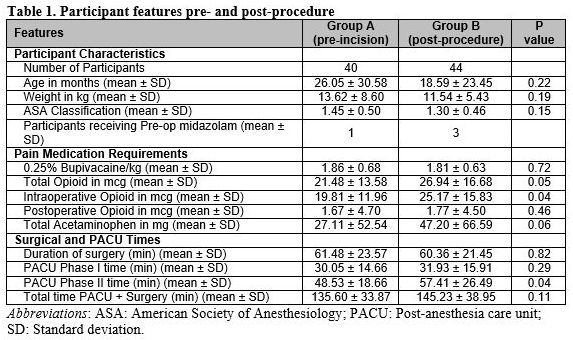PR2-173
Comparison of dorsal penile nerve block at the beginning versus conclusion of circumcision repair in children for postoperative pain control: A randomized controlled trial
Bilal R, Kale R, Moore L, Daugherty M, Riddell J
SUNY UpState Medical University, Syracuse, NY, United states
Introduction: This study was conducted to determine the optimal time to perform dorsal penile nerve block (DPNB) in regard to postoperative pain control for pediatric patients undergoing circumcision. Performing nerve blocks prior to tissue damage is well documented to result in better postoperative pain control and reduced pain medication requirements (1,2). To our knowledge, this has not been investigated for pediatric patients undergoing circumcision. We hypothesized that pediatric patients receiving pre-incision DPNB would require less opioid medication than those receiving DPNB post-procedure.
Methods: In this study, ninety-eight participants were recruited at the State University of New York UpState Medical University from 11/2014 through 9/2015; 44 were enrolled into Group A (pre-incision DPNB) and 40 into Group B (post-procedure DPMB). All participants were male, American Society of Anesthesiology physical classification status I or II and < 12 years old. Each participant received general anesthesia maintained with sevoflurane, and airway management using laryngeal mask airway. Pain medication administration was at the discretion of the anesthesiologist and the post-anesthesia care unit (PACU) nurse. The circumcision technique was performed per standard procedure, with the only difference between groups being administration of the block pre-incision (Group A) or post-procedure but before emergence from general anesthesia (Group B). Pre-procedure participant features were compared between groups using a two-tailed paired t-test. Analysis of multiple variables was carried out including duration of surgery, medication requirements and discharge times using a single-tailed paired t-test.
Results: Pre-procedure participant characteristics were similar between the groups (p > 0.05). Length of surgical time was not different between the groups (p = 0.82). Participants in the pre-incision block group required less opioid medication (p = 0.04) and had a shorter phase II PACU time (p = 0.04).
Discussion: This trial found pre-incision to be the optimal time to perform DPNB regarding postoperative pain control for pediatric patients undergoing circumcision. The resulting reduction in total opioid consumption (per our hypothesis) and reduced phase II PACU time should aid in reducing postoperative complications for pediatric patients, as well as reduce the stress and length of their hospital experience.
Conclusions: With regard to pediatric patients undergoing circumcision, the optimum time to perform DPNB is pre-incision.
References:
1. Ejlersen E, Andersen HB, Eliasen K, Mogensen T. A comparison between preincisional and postincisional lidocaine infiltration and postoperative pain. Anesthesia & Analgesia. 1992;74(4):495-498.
2. Chhibber AK, Perkins FM, Rabinowitz R, Vogt AW, Hulbert WC. Penile block timing for postoperative analgesia of hypospadias repair in children. The Journal of Urology. 1997;158(3 Pt 2):1156-1159.
Top












